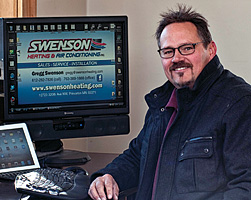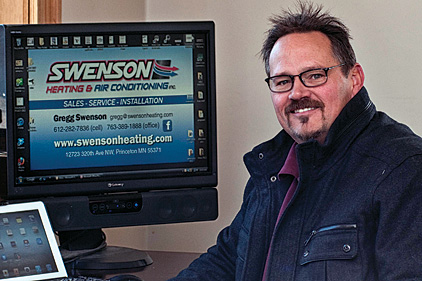
|
| Gregg Swenson is letting the public know about the new efficiency standards, which he says may completely rule out the possibility of some clients being able to afford a new furnace. |
Barring any changes stemming from the pending lawsuit against the Department of Energy (DOE), the new regional efficiency standards for residential furnaces, air conditioners, and heat pumps are scheduled to become effective May 1, 2013. The new rules will affect residential furnaces first, by mandating that nonweatherized furnaces installed in Northern states after that date meet a minimum efficiency of 90 percent AFUE.
This has caused some concern for contractors, who are still waiting to hear from the DOE about how the new standards will be enforced, especially in regard to unscrupulous contractors who could theoretically bring lower efficiency furnaces across state lines. They also worry about the homes in which installing a condensing furnace will be extremely difficult and/or expensive, due to venting and drainage requirements.
But some Northern contractors see a silver lining to this latter concern, as they view this as an opportunity to boost sales of 80 percent AFUE furnaces before they are no longer available in their area.
Getting the Word Out
Being in a border state is a special concern to Butch Welsch, president/owner, Welsch Heating and Cooling, St. Louis, Mo., who worries that contractors could bring back truckloads of 80 percent AFUE furnaces from Kentucky and Tennessee after the standards take effect.
“I have no idea how that is ever going to be policed. I just can’t see it. We know that the manufacturers can’t be policed, because they’ll still be able to make 80 percent efficient furnaces. We know that distributors are going to be allowed to stock and sell 80 percent efficient furnaces if they’re servicing different regions. That means it comes down to contractors, and quite frankly, I don’t trust them to be honest about it. There are always going to be those who are going to cheat the system.”
While Welsch can’t control what other contractors do after the standards take effect, he has decided to approach the issue proactively, by posting information on his website, sending out press releases to the media, and mailing letters to his customer base.
“We’re not saying the sky is falling — we just want people to be aware of the new standard. If they have a 15-year-old furnace, and it’s in a difficult place, then we highly recommend that they change it before May 2013. We’re doing everything we can to make people aware of the situation now.”
Travis Smith, owner/general manager, Sky Heating & AC, Portland, Ore., is letting customers know at the time of service that if they are contemplating a new 80 percent AFUE furnace, then they only have a few months left to do it. “Most do not know about the new standards until our technicians tell them about it. As a result, we are replacing a few furnaces that we might not have before, due to the difficulty of installing a 90 percent-plus AFUE furnace or because the less efficient furnaces are being used as backups to heat pumps or to heat very small areas.”
Posting the information on their website, as well as on social networking sites, is the main way in which Swenson Heating & Air Conditioning Inc., Princeton, Minn., is letting the public know about the new efficiency standards. “Hopefully, this will spur replacements in difficult situations prior to the rule change,” said company partner Gregg Swenson, “as this new law may completely rule out the possibility of some clients being able to afford a new furnace.”
Installation Concerns
Swenson worries about numerous clients who reside in multifamily units, where it will be extremely difficult to install condensing furnaces due to available space and venting requirements. “In some circumstances it would require very costly remodeling to make this a possibility. For example, in many townhome units, the furnace is located in a small closet in the center of the home, and there is no extra space for a wider condensing furnace without moving walls, which could, in turn, affect bathrooms or kitchens.”
Venting would also be a concern, added Swenson, as it might require installing chases through the bedrooms and bathrooms, or lowering ceilings in multiple rooms. In addition, exterior wall space is often limited, and there may be windows that make it impossible to gain clearances from flue vents. “Code changes to allow exhaust venting closer to doors and windows could alleviate this, but it would be a safety concern.”
Scott Merritt, president/owner, Fire & Ice Heating and Air Conditioning, Columbus, Ohio, shares the concern about customers in multifamily housing, as many condominiums in his area have 80 percent AFUE furnaces in the attic. If forced to replace those units with 90 percent AFUE furnaces, it would become necessary to build a heated room around the furnace, so that the condensation from the furnace would not freeze.
“There would also be problems with that same condensation being drained,” said Merritt.
“Currently many of our condo units have drain lines that run down the inside of the outside wall. That drain line does not freeze in the winter because it is not being used, but we cannot use it with 90-percent-plus furnaces because of freezing. So, another unsightly drain will have to be run down into the house somewhere. All these things will add a lot of extra time and money for the homeowner.”
To make his customers aware of the new standard, Merritt has been giving presentations at condo association board meetings, telling customers about it on service calls, and advertising it at trade shows.
“We have also done some direct mail to specific types of homes like these condos, letting them know that the pricing for furnaces will shoot through the roof next year and that this is the last year to get an economical furnace. We will also have it up on our website very soon, and we will be directing our social media efforts to the website so that homeowners can read up on it.”
Customer Feedback
Most contractors state that homeowners are not currently aware of the new standards that go into effect next year. Indeed, Swenson stated that not only do most of his customers not know about the rule changes, several city building inspectors do not know about it, either. “Customers aren’t concerned yet, but I expect that to change as more people become aware of this new law. For the customers who are aware of the new laws, it has most definitely prompted some furnace replacements, mainly by landlords of rental properties and townhomes, where they are concerned about cost and restrictive installation possibilities.”
Once customers do learn about the new standards, their first reaction is often anger, said Merritt. “People are mad because the government is telling them what they can and cannot buy. This breeds mistrust of the whole industry and hurts us all. We sell a lot of high-efficiency units now. We are never the cheapest, but we are one of the best, because quality costs money. Once people are forced to buy a 90-percent furnace, they will be unhappy, and some will look for the cheapest alternative. When you force someone’s hand and make them spend more than they want to, you won’t be able to make them spend even more for quality installation, because it just isn’t in the budget. This could potentially cause low quality installations by low price-point companies.”
Cutting corners by installing a condensing furnace poorly may definitely occur when the new efficiency standards take effect, said Welsch. “To install a 90-percent furnace correctly, you need a two-pipe PVC system — for intake and exhaust. The systems will work just using PVC for the exhaust, but it’s not the correct way to do things. I’m sure there will be a lot of guys just doing one-pipe systems instead of two, because it’s cheaper.”
In homes in which it will be difficult to install a condensing furnace, Smith believes that some contractors will not pull permits in order to install lower efficiency equipment. “This will not only harm our business, but when equipment is installed without permits, it could hinder home sales and cause insurance issues for the homeowner if the illegally installed furnace causes a fire or other harm. We plan to report any contractors who we find are breaking the law in our area, and we will install all furnaces to code and with permits after the change on May 1st.”
The new rules will ultimately be implemented, but in the end, Welsch questions whether the government should be involved in mandating efficiency standards at all.
“If somebody wants to buy a 50-percent efficient furnace and is willing to pay the utility bills that go along with that equipment, they ought to be able to do that. The market should govern which efficiency furnace is used. It’s typical when the government gets involved in something they really shouldn’t, then enforcement becomes very difficult. Just look at what happened with R-22. We thought it was gone, and now dry ship units make up 20 percent of the market. It’s ridiculous.”
Publication date: 11/26/2012



Report Abusive Comment